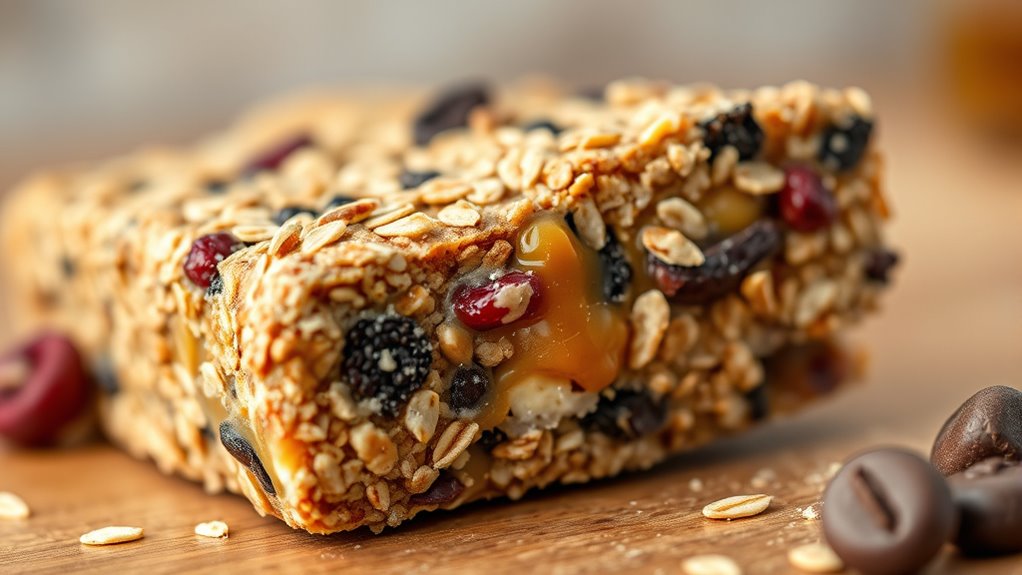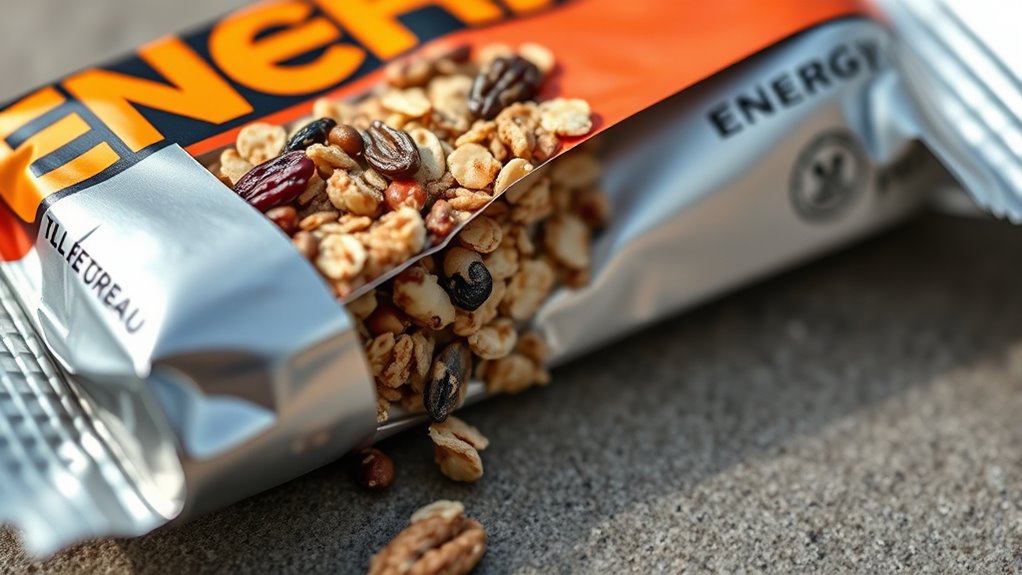Labels on energy bars often hide the truth about your endurance. Terms like “natural” or “whole grain” can be misleading, and front claims such as “low calorie” don’t reveal high sugar or processed ingredients inside. Hidden sugars cause energy spikes followed by crashes, while artificial additives offer little real nutrition. To truly sustain stamina, you need to look past the labels and understand what’s in every bar—keep going to discover the secrets that can boost your performance.
Key Takeaways
- Labels often highlight “natural” or “whole grain” claims without indicating actual ingredient quality or sugar content.
- Hidden sugars like high-fructose corn syrup and glucose can cause blood sugar spikes and energy crashes.
- Many energy bars contain highly processed ingredients that lack natural nutrients and offer minimal sustained energy.
- Artificial flavorings and preservatives are common and can undermine the long-term health benefits of the snack.
- Reading ingredient lists helps identify high-quality, minimally processed components that support steady endurance.

Ever wonder what’s really inside your energy bar? Many of us grab what looks like a quick fix without truly understanding what’s packed inside. The labels can be deceiving, especially when it comes to sugar content and ingredient quality. While those colorful wrappers promise sustained endurance, they often hide a mix of processed ingredients and hidden sugars. You might see “natural” or “whole grain” labels, but that doesn’t always mean what you think. The sugar content varies widely and can be sneakily high, especially in bars that are marketed as healthy. A bar might boast a low calorie count or claim to be “all-natural,” but if it’s loaded with added sugars, it could cause a spike in blood sugar levels followed by a crash, leaving you feeling sluggish instead of energized. It’s essential to scrutinize the ingredient list rather than relying solely on front-label claims. If you see ingredients like high-fructose corn syrup, cane sugar, or glucose syrup listed early, that’s a red flag. These added sugars don’t just sweeten the bar—they can hinder your stamina and recovery over time.
Ingredient quality plays an equally important role. Many energy bars are made with highly processed components that strip away natural nutrients, leaving behind empty calories. Think about the difference between whole nuts, oats, and dried fruits versus refined flour or artificial flavorings. The more processed the ingredients, the less nutritional value you’re getting for your effort. Look for bars that highlight whole-food ingredients, minimal processing, and recognizable components. High-quality ingredients provide more sustained energy because they digest more slowly, helping to maintain your endurance without the dreaded sugar crash. If the ingredient list reads like a chemistry experiment—containing preservatives, artificial sweeteners, or synthetic flavorings—you’re not doing your body any favors. Instead, opt for options that prioritize natural, whole ingredients, which support longer-lasting energy and better overall health.
Understanding what’s inside your energy bar helps you make smarter choices. Labels can be misleading, but by paying attention to sugar content and ingredient quality, you get a clearer picture of how your snack will impact your endurance. Don’t fall for marketing tricks—look beyond the front and read the fine print. Your body responds best to real, wholesome foods that fuel you properly, so choose bars with simple, high-quality ingredients and moderate sugar levels. That way, you’re not just fueling your workout but also supporting your long-term health and stamina.
Frequently Asked Questions
How Do Artificial Sweeteners in Energy Bars Affect Long-Term Health?
Artificial sweeteners in energy bars can impact your long-term health in various ways. While they’re often used to reduce calorie intake, some studies suggest they might disrupt your gut bacteria or increase cravings for sweet foods over time. You should stay cautious and monitor how your body reacts. Although generally considered safe in moderation, it’s wise to limit artificial sweeteners to support better long-term health outcomes.
Are Organic Energy Bars More Effective Than Non-Organic Options?
You might wonder if organic energy bars are more effective than non-organic ones. With organic certification, you get ingredient purity and fewer synthetic additives, which can support better digestion and sustained energy. While they may not always outperform non-organic options in immediate performance, their cleaner ingredients often promote overall health and endurance over time. Choosing organic can be a smarter choice for long-term wellness and consistent energy support.
What Is the Ideal Calorie Count for Sustained Endurance?
Think of your body as a finely tuned engine; fueling it right keeps you going. For sustained endurance, aim for about 200-300 calories per hour, depending on your energy requirements and workout intensity. Maintaining a balanced calorie intake helps you avoid burnout and keeps your energy levels steady. Listen to your body’s signals, and adjust your intake to match your calorie balance, ensuring you stay in the race longer.
Do Energy Bars With Added Electrolytes Improve Hydration?
You might wonder if energy bars with added electrolytes boost hydration. They can improve electrolyte absorption, which helps your body maintain proper fluid balance. This, in turn, enhances hydration efficiency, especially during long workouts or races. While they’re not a substitute for water, these bars support your hydration strategy by replenishing lost minerals and aiding in quicker recovery. Just remember, combining them with adequate water intake maximizes their benefits.
How Do Different Protein Types Impact Recovery and Performance?
Think of different protein types as keys opening your recovery. Whey protein digests quickly, delivering amino acids fast to repair muscles, while casein digests slowly, providing a steady supply. Plant-based proteins may have incomplete amino acid profiles but can be combined for full benefits. Your choice impacts performance and recovery, so select based on how your body processes protein digestion to optimize healing and endurance after workouts.
Conclusion
Don’t be fooled by flashy labels or quick claims—your energy bar’s true story is in the ingredients and nutritional info. Like a trusty steed in a knight’s quest, it’s your ally for sustained endurance, not just a sugar rush. Remember, reading labels isn’t just a modern habit; even Sir Lancelot would want to know what fuels his joust. So, choose wisely and power through your day with bars that support real stamina, not just a fleeting boost.










